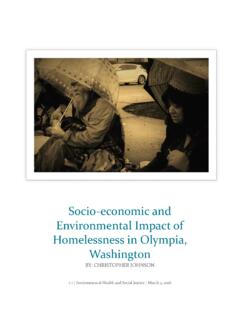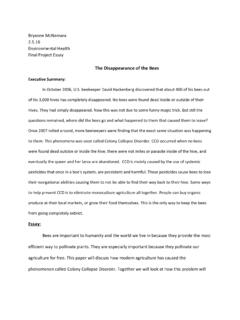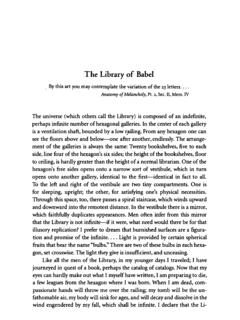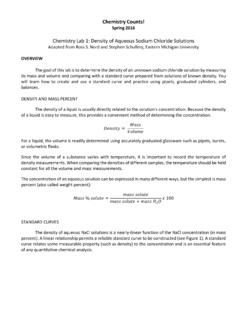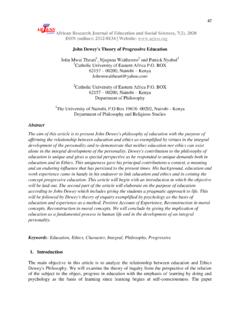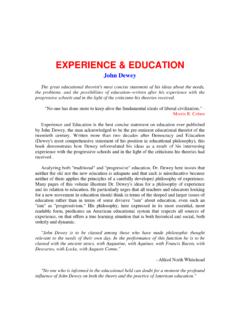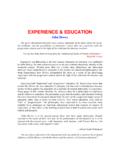Transcription of ART AS EXPERIENCE-
1 ART AS EXPERIENCE- BY john dewey CAPRICORN BOOKS NEW YORK COPYRIGHT@ 1934, BY john dewey . ALL RIC:HTS RESERVED. Capricorn Books, G. P. Putnam's Sons, New Y01 k 1958 Fourteenth Impression Library of Congress Catalog Card Number: 58-59756 MANUFACTURED IN THE UNITED STATES OF A l ERICA CHAPTER I THE LIVE CREATURE By ONE of the ironic perversities that often attend the course of affairs, the existence of the works of art upon which forma tion of an esthetic theory depends has become an obstruction to theory about them. For one reason, these works are products that exist externally and physically. In common conception, the work of art is often identified with the building, book, painting, or statue in its existence apart from human experience .
2 Since the actual work of art is what the product does with and in experience , the result is not favorable to understanding. In addition, the very perfection of some of these products, the prestige they possess because of a long history of unquestioned admiration, creates conventions that get in the way of fresh insight. When an art product once attains classic status, it somehow becomes isolated from the human conditions under which it was brought into being and from the human consequences it engenders in actual life experience . When artistic objects are separated from both conditions of origin and operation in experience , a wall is built around them that renders almost opaque their general significance, with which esthetic theory deals.
3 Art is remitted to a separate realm, where it is cut off from that association with the materials and aims of every other form of human effort, undergoing, and achievement. A primary task is thus imposed upon one who undertakes to write upon the philosophy of the fine arts. This task is to restore con- tinuity between the refined and intensified forms of experience that are works of art and the everyday events, doings, and suffer ings that are universally recognized to constitute experience . Mountain peaks do not float unsupported; they do not even just rest upon the earth. They are the earth in one of its manifest oper ations. It is the business of those who are concerned with the theory of the earth, geographers and geologists, to make this fact 4 art as experience evident in its various implications.
4 The theorist who would deal philosophically with fine art has a like task to accomplish. If one is willing to grant this position, even if only by way of temporary experiment, he will see that there follows a conclu sion at first sight surprising. In order to understand the meaning of artistic products, we have to forget them for a time, to turn aside from them and have recourse to the ordinary forces and conditions of experience that we do not usually regard as esthetic. We must arrive at the theory of art by means of a detour. For theory is concerned with understanding, insight, not without ex clamations of admiration, and stimulation of that emotional out burst often called appreciation.
5 It is quite possible to enjoy flowers in their colored form and delicate fragrance without knowing any thing about plants theoretically. But if one sets out to understand the flowering of plants, he is committed to finding out something about the interactions of soil, air, water and sunlight that con dition the growth of plants. By common consent, the Parthenon is a great work of art. Yet it has esthetic standing only as the work becomes an experience for a human being. And, if one is to go beyond per sonal enjoyment into the formation of a theory about that large republic of art of which the building is one member, one has to be willing at some point in his reflections to turn from it to the bustling, arguing, acutely sensitive Athenian citizens, with civic sense identified with a civic religion, of whose experience the temple was an expression, and who built it not as a work of art but as a civic commemoration.
6 The turning to them is as human beings who had needs that were a demand for the building and that were carried to fulfillment in it; it is not an examination such as might be carried on by a sociologist in search for material relevant to his purpose. The one who sets out to theorize about the esthetic experience embodied in the Parthenon must realize in thought what the people into whose lives it entered had in common, as creators and as those who were satisfied with it, with people in our own homes and on our own streets. In order to understand the esthetic in its ultimate and approved forms, one must begin with it in the raw; in the events and scenes that hold the attentive eye and ear of man, arous ing his interest and affording him enjoyment as he looks and THE LIVE CREATURE 5 listens: the sights that hold the crowd-the fire-engine rushing by; the machines excavating enormous holes in the earth; the human-fly climbing the steeple-side; the men perched high in air on girders, throwing and catching red-hot bolts.
7 The sources of art in human experience will be learned by him who sees how the tense grace of the ball-player infects the onlooking crowd; who notes the delight of the housewife in tending her plants, and the intent interest of her goodman in tending the patch of green in front of the house; the zest of the spectator in poking the wood burning on the hearth and in watching the darting flames and crumbling coals. These people, if questioned as to the reason for their actions, would doubtless return reasonable answers. The man who poked the sticks of burning wood would say he did it to make the fire burn better; but he is none the less fascinated by the colorful drama of change enacted before his eyes and imagina tively partakes in it.
8 He does not remain a cold spectator. What Coleridge said of the reader of poetry is true in its way of all who are happily absorbed in their activities of mind and body: "The :t reader should be carried forward, not merely or chiefly by the j mechanical impulse of curiosity, not by a restless desire to arrive at the final solution, but by the pleasurable activity of the journey' itself." The intelligent mechanic engaged in his job, interested in doing well and finding satisfaction in his handiwork, caring for his materials and tools with genuine affection, is artistically en gaged. The difference between such a worker and the inept and careless bungler is as great in the shop as it is in the studio.
9 Often times the product may not appeal to the esthetic sense of those who use the product. The fault, however, is oftentimes not so much with the worker as with the conditions of the market for which his product is designed. Were conditions and opportunities different, things as significant to the eye as those produced by earlier craftsmen would be made. So extensive and subtly pervasive are the ideas that set Art upon a remote pedestal, that many a person would be repelled rather than pleased if told that he enjoyed his casual recreations, in part at least, because of their esthetic quality. The arts which today have most vitality for the average person are things he does not take to be arts: for instance, the movie, jazzed music, 6 art as experience the comk strip, and, too frequently, newspaper accounts of love nests, murders, and exploits of bandits.
10 For, when <!! he knows as art is relegated to the_!nuseum and gallery, the unconquerable impulse towards experiences enjoyable in themselves finds such outlet as the daily environment provides. Many a person who protests against the museum conception of art, still shares the fallacy from which that conception springs. For the popular notion comes from a separation of art from the objects and scenes of ordinary experience that many theorists and critics pride themselves upon holding and even elaborating. The times when select and distinguished objects are closely connected with the products of usual vocations are the times when appreciation of the former is most rife and most keen.


